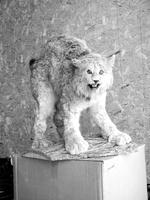|
The Sublette County Journal Volume 4, Number 16 - 12/16/99 brought to you online by Pinedale Online The Neelys trapped 13 lynx that one winter by Rob Shaul "They were easy to trap," says Pinedale old-timer Bucky Neely of his experiences trapping lynx in the Wyoming Range during the winter of 1972-1973. "Once we found a track, we had a cat the next weekend," he continues. That winter, Bucky and his son, Gary, trapped 13 lynx. This was the first winter that Bucky had ever tried to trap lynx. He says his Uncle Buck used to trap the cats in the old days and he remembers one year when lynx kept getting into the shed where Ross Meeks had hung a deer he'd shot that hunting season. Bucky decided to try and trap lynx in 1972 after he saw three or four of the cats while guiding hunters during the elk season. He'd never seen a lynx before that hunting season. The first lynx he saw that season he remembers as very tame and gentle. The cat was sitting beneath a pine tree and Bucky was able to approach it to within 10 yards. The cat eventually fled and was shot by a hunter from Texas whom Bucky was guiding. The hunter took the lynx back to Texas and had it mounted on a mountain lion form. The mount turned out really "ugly" says Bucky. In 1972, lynx pelts were bring $35. Bucky used large steal-jaw traps - Blake & Lamb #44s - with 7 1/2" jaws. "Lynx have big feet so you need a big trap," he explains. After finding tracks, Bucky would find a spot to set the trap somewhere along the lynx's regular rounds. He would tramp the snow down below the trap so it was hard and he used a whole or half-beaver carcass for bait. The beaver would be hung three or four feet in the air from a balsam tree, and two or three traps would be placed one or two feet apart below and surrounding the bait. Bucky would use pine bows to make a covey to force the lynx to approach the bait from one direction and would hang a chicken wing to catch the cat's eye as it passed by. As the cat would reach up to take the bait, it would step in one of the traps. Bucky says the lynx were easy to trap. Unlike for coyotes, the traps didn't have to be covered completely with snow - part of the trap or wire could be showing and the trap would still be effective. The lynx were "not trap shy," says Bucky, "they were plumb stupid that way." All of the lynx the Neelys caught were full grown, adult animals, says Bucky. The animals "had no weight to them," he continues, and weighed an average of 21 pounds. As a comparison, Bucky says bobcats that big would have weighed 30-35 pounds. He describes the lynx as being very tall - "three feet" - with slim flanks. The Neelys kept the last lynx they trapped that year, and Bucky mounted it using a large bobcat form. He says companies didn't make forms for lynx back then. Bucky continues that one interesting thing about the lynx is that they were "loaded with fleas." Sometimes it would be a month and a half before the Neely's got around to skinning the cats and the entire time the carcasses would be kept frozen out in a shed. However, the cold didn't seem to affect the fleas, which came back to life when the Neely's thawed the cats out for skinning. Bucky says they had to use a special type of Raid to kill the fleas. Opinions on Listing and Management Mr. Neely is against listing the lynx. "I'd hate to see them put 'em on the endangered species list, he says. Bucky believes clear cutting has done the most damage to the lynx populations, however, he doesn't believe bobcats are displacing the animals. In his experience, bobcats don't winter in the high country where he found the lynx. He also doesn't think lynx and coyotes bother each other. Despite the Neely's success in trapping coyotes that winter, Bucky says all their profits were spent on snowmachine belts they'd burn up getting unstuck in the deep snow. The old sleds were a lot different than today's sleds, he notes. Photo credits: Photo courtesy Bucky Neely See The Archives for past articles. Copyright © 1999 The Sublette County Journal All rights reserved. Reproduction by any means must have permission of the Publisher. The Sublette County Journal, PO Box 3010, Pinedale, WY 82941 Phone 307-367-3713 Publisher/Editor: Rob Shaul editor@scjonline.com |
